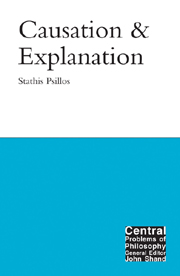4 - Causation and mechanism
from I - Causation
Summary
Hume couldn't see the link between cause and effect. For his followers, causation, as it is in the objects, just is regular succession. In this chapter, our focus will be some prominent philosophical attempts to show that there is more to causation than regular succession by positing a mechanism that links cause and effect. We shall start with Mackie's argument and move on to examine Salmon's and Phil Dowe's theories of causation. In the final section, I shall attempt to offer a conceptual guide to the theories we have discussed in the first part of the book.
Persistence
Although Mackie has been a critic of RVC, he does not deny that complex regularities are “part of causation in the objects” (1974: 194). It is only a part though, since, as he claims, RVC leaves out an important aspect of causation as it is in the objects; namely, necessity. As Hume noted, the alleged necessary tie between cause and effect is not observable. But Mackie thinks, not unreasonably, that we may still hypothesize that there is such a tie, and then try to form an intelligible theory about what it might consist in. His hypothesis is that the tie consists in a “causal mechanism”, that is, “some continuous process connecting the antecedent in an observed … regularity with the consequent” (1974: 82). Where Humeans, generally, refrain from accepting anything other than spatiotemporal contiguity between cause and effect, Mackie thinks that mechanisms might well constitute “the long-searched-for link between individual cause and effect which a pure regularity theory fails, or refuses, to find” (1974: 228–9).
- Type
- Chapter
- Information
- Causation and Explanation , pp. 107 - 134Publisher: Acumen PublishingPrint publication year: 2002

